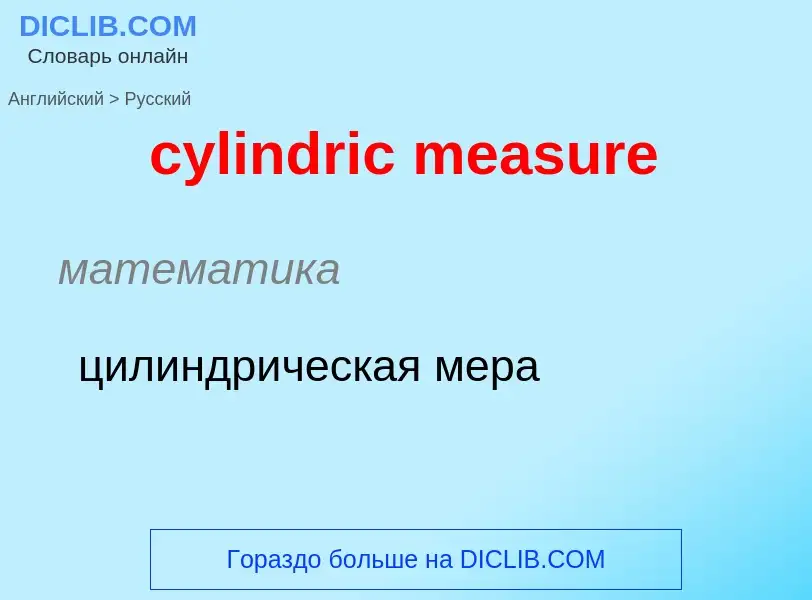Translation and analysis of words by ChatGPT artificial intelligence
On this page you can get a detailed analysis of a word or phrase, produced by the best artificial intelligence technology to date:
- how the word is used
- frequency of use
- it is used more often in oral or written speech
- word translation options
- usage examples (several phrases with translation)
- etymology
cylindric measure - translation to russian
математика
цилиндрическая мера
['ki:p'daun]
общая лексика
не вставать, продолжать сидеть или лежать
подавлять (восстание чувство)
держать в подчинении
уничтожать
оставлять на второй год
фразовый глагол
общая лексика
продолжать сидеть или лежать
не вставать
не поднимать
подавлять
сдерживать
мешать успеху
росту и т. п.
не допускать повышения
Definition
Wikipedia
In mathematics, cylindrical algebraic decomposition (CAD) is a notion, and an algorithm to compute it, that are fundamental for computer algebra and real algebraic geometry. Given a set S of polynomials in Rn, a cylindrical algebraic decomposition is a decomposition of Rn into connected semialgebraic sets called cells, on which each polynomial has constant sign, either +, − or 0. To be cylindrical, this decomposition must satisfy the following condition: If 1 ≤ k < n and π is the projection from Rn onto Rn−k consisting in removing the last k coordinates, then for every pair of cells c and d, one has either π(c) = π(d) or π(c) ∩ π(d) = ∅. This implies that the images by π of the cells define a cylindrical decomposition of Rn−k.
The notion was introduced by George E. Collins in 1975, together with an algorithm for computing it.
Collins' algorithm has a computational complexity that is double exponential in n. This is an upper bound, which is reached on most entries. There are also examples for which the minimal number of cells is doubly exponential, showing that every general algorithm for cylindrical algebraic decomposition has a double exponential complexity.
CAD provides an effective version of quantifier elimination over the reals that has a much better computational complexity than that resulting from the original proof of Tarski–Seidenberg theorem. It is efficient enough to be implemented on a computer. It is one of the most important algorithms of computational real algebraic geometry. Searching to improve Collins' algorithm, or to provide algorithms that have a better complexity for subproblems of general interest, is an active field of research.

, as Vicentio in 'Measure for Measure' by William Shakespeare, 1794 British School Victoria and Albert Museum.jpg?width=200)
![Robert Smirke]] (n.d.) Robert Smirke]] (n.d.)](https://commons.wikimedia.org/wiki/Special:FilePath/'Measure for Measure', Act II, Scene 1, the Examination of Froth and Clown by Escalus and Justice (from the Boydell series) Robert Smirke (1753–1845) Royal Shakespeare Theatre.jpg?width=200)
![The first page of Shakespeare's ''Measure for Measure'', printed in the [[First Folio]] of 1623 The first page of Shakespeare's ''Measure for Measure'', printed in the [[First Folio]] of 1623](https://commons.wikimedia.org/wiki/Special:FilePath/First-page-first-folio-measure-for-measure.jpg?width=200)
![William Hamilton]] of Isabella appealing to Angelo William Hamilton]] of Isabella appealing to Angelo](https://commons.wikimedia.org/wiki/Special:FilePath/Isabella appealing to Angelo (Hamilton, 1793).jpg?width=200)
![''Mariana'' (1851) by [[John Everett Millais]] ''Mariana'' (1851) by [[John Everett Millais]]](https://commons.wikimedia.org/wiki/Special:FilePath/John Everett Millais - Mariana - Google Art Project.jpg?width=200)
![Pompey Bum, as he was portrayed by nineteenth-century actor [[John Liston]] Pompey Bum, as he was portrayed by nineteenth-century actor [[John Liston]]](https://commons.wikimedia.org/wiki/Special:FilePath/John Liston as Pompey in Measure for Measure by William Shakespeare (cropped).jpg?width=200)
![''Mariana'' (1888) by [[Valentine Cameron Prinsep]] ''Mariana'' (1888) by [[Valentine Cameron Prinsep]]](https://commons.wikimedia.org/wiki/Special:FilePath/Prinsep - Mariana.jpg?width=200)
![''Isabella'' (1888) by [[Francis William Topham]] ''Isabella'' (1888) by [[Francis William Topham]]](https://commons.wikimedia.org/wiki/Special:FilePath/Topham - Isabella.jpg?width=200)
![''Claudio and Isabella'' (1850) by [[William Holman Hunt]] ''Claudio and Isabella'' (1850) by [[William Holman Hunt]]](https://commons.wikimedia.org/wiki/Special:FilePath/William Hunt Claudio and Isabella Shakespeare Measure for Measure.jpg?width=200)
